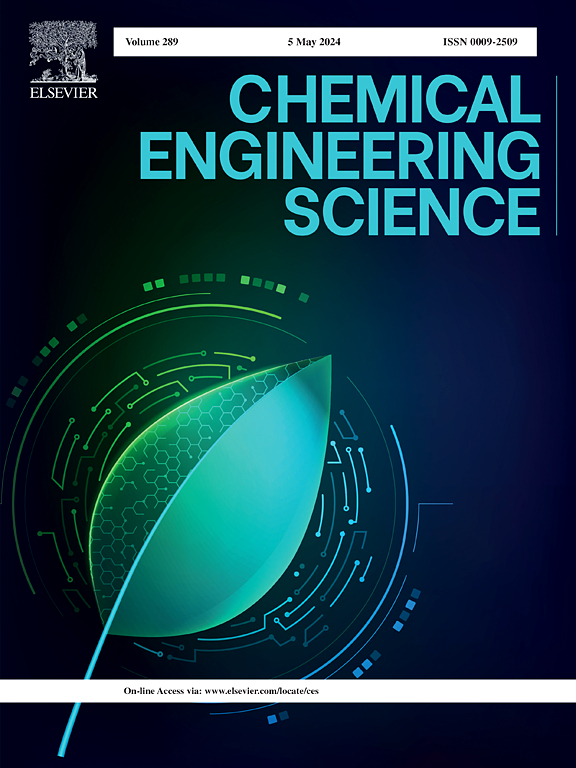硫酸盐溶液中二氧化碳水合物解离压力的实验测量和热力学建模
IF 4.1
2区 工程技术
Q2 ENGINEERING, CHEMICAL
引用次数: 0
摘要
碳捕集与封存(CCS)一直是减缓气候变化的热门战略,并引起了工业界和学术界的极大关注。二氧化碳可以以二氧化碳水合物的形式储存在海洋深处,这使其成为二氧化碳封存的潜在选择。海洋盐水中的溶解盐会严重影响二氧化碳水合物的解离压力。硫酸盐是海洋盐水中最常见的盐类之一。虽然已经开展了各种实验研究来探讨二氧化碳水合物在盐水中的相行为,但很少有研究关注硫酸盐盐对二氧化碳水合物解离压力的影响。在本研究中,我们建立了一个内部实验装置来研究一价和二价硫酸盐对 CO2 水合物解离压力的影响。在温度范围为 274.36-282.15 K 和压力范围为 1.50-4.03 MPa 的条件下,采用等时压力搜索法测量了 Na2SO4、K2SO4、MgSO4 和 CuSO4 水溶液中二氧化碳水合物的解离压力。该方法结合了Soave-Redlich-Kwong状态方程(SRK EOS)、范德华-普拉蒂奥乌(vdW-P)模型和皮策模型,用于预测硫酸盐溶液中二氧化碳的解离压力。此外,还根据测得的解离点,使用克劳修斯-克拉皮隆方程计算了这些硫酸盐溶液中二氧化碳水合物的解离焓。实验结果表明,Na2SO4、K2SO4 和 MgSO4 溶液中二氧化碳水合物的解离压高于纯水中的解离压,而且随着盐浓度的增加,硫酸盐溶液中二氧化碳水合物的解离压也会增加。相反,CuSO4 几乎不影响 CO2 水合物的解离压,这主要是因为与其他盐溶液相比,CuSO4 的离子摩尔浓度较低,而且 Cu2+ 具有离子特异性。预测结果与本研究测量的实验数据一致,这证明了热力学模型预测硫酸盐溶液中 CO2 水合物解离压的可行性。此外,计算得出的 CO2 水合物解离焓与温度和盐浓度都有关系。研究还发现,Cu2+ 在影响 CO2 水合物解离焓方面表现出离子特异性,这可能是由于与其他离子相比,Cu2+ 对 CO2 水合物的笼占位具有独特的影响能力。这些发现加深了我们对硫酸盐对二氧化碳水合物解离行为的影响的理解,并为二氧化碳封存提供了宝贵的见解。本文章由计算机程序翻译,如有差异,请以英文原文为准。
Experimental measurements and thermodynamic modeling of dissociation pressure of CO2 hydrate in sulfate solutions
Carbon capture and storage (CCS) has been a popular strategy to mitigate climate change and has attracted significant attention from both industry and academia. CO2 can be stored in the form of CO2 hydrate in deeper locations in an ocean, which makes it a potential option for CO2 sequestration. Dissolved salts in the ocean brine can significantly affect the dissociation pressure of CO2 hydrate. Sulfate salts are one of the most common salt species in the oceanic brine. Although various experimental studies have been conducted to investigate the phase behavior of CO2 hydrate in brine, few studies focus on the effect of sulfate salts on the dissociation pressure of CO2 hydrate. In this study, we build an in-house experimental setup to investigate the effect of monovalent and divalent sulfate salts on the dissociation pressure of CO2 hydrate. The dissociation pressure of CO2 hydrate in Na2SO4, K2SO4, MgSO4, and CuSO4 aqueous solutions is measured using the isochoric pressure search method at different concentrations over the temperature range of 274.36 – 282.15 K and the pressure range of 1.50 – 4.03 MPa. A hybrid methodology incorporating the Soave-Redlich-Kwong Equation of State (SRK EOS), the van der Waals-Platteeuw (vdW-P) model, and the Pitzer model is applied to predict the dissociation pressure of CO2 in sulfate solutions. In addition, the dissociation enthalpies of CO2 hydrate in these sulfate solutions are calculated using the Clausius-Clapeyron equation based on the measured dissociation points. The experimental results show that the dissociation pressure of CO2 hydrate in Na2SO4, K2SO4, and MgSO4 solutions is higher than that in pure water, and the dissociation pressure of CO2 hydrate in sulfate solutions increases with an increasing salt concentration. Conversely, CuSO4 barely affects the dissociation pressure of CO2 hydrate, which is mainly attributed to the lower molar concentration of the ions compared with the other salt solutions and the ion specificity of Cu2+. The prediction results are in alignment with the experimental data measured in this study, which proves the feasibility of the thermodynamic model in predicting the dissociation pressure of CO2 hydrate in sulfate solutions. Additionally, the calculated dissociation enthalpies of CO2 hydrate show a dependence on both temperature and salt concentration. It is also revealed that Cu2+ exhibits ion specificity in affecting the dissociation enthalpy of CO2 hydrate, likely due to its more distinct ability to impact the cage occupancy of CO2 hydrate than the other ions. These findings enhance our understanding of the impact of sulfate salts on the dissociation behavior of CO2 hydrate and offer valuable insights for CO2 sequestration.
求助全文
通过发布文献求助,成功后即可免费获取论文全文。
去求助
来源期刊

Chemical Engineering Science
工程技术-工程:化工
CiteScore
7.50
自引率
8.50%
发文量
1025
审稿时长
50 days
期刊介绍:
Chemical engineering enables the transformation of natural resources and energy into useful products for society. It draws on and applies natural sciences, mathematics and economics, and has developed fundamental engineering science that underpins the discipline.
Chemical Engineering Science (CES) has been publishing papers on the fundamentals of chemical engineering since 1951. CES is the platform where the most significant advances in the discipline have ever since been published. Chemical Engineering Science has accompanied and sustained chemical engineering through its development into the vibrant and broad scientific discipline it is today.
 求助内容:
求助内容: 应助结果提醒方式:
应助结果提醒方式:


